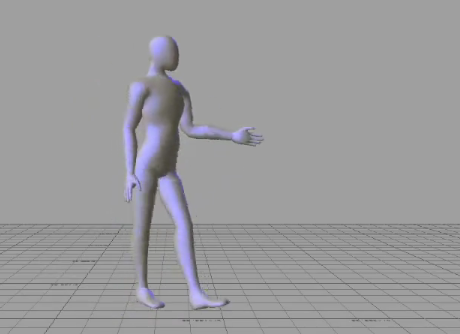The theory of sexual selection proposes that certain traits evolved due to the preference of the other gender. These preferences may evolve because the trait is an indicator or genetic fitness, for example through being related to better health. Random genetic mutations that lead an individual to better display this trait are make that person “sexier” to the other sex, and hence the gene is more likely to make it into the next generation.

T1000 Getting jiggy with it. John Connor, get down!!
Many such traits are physical characteristics, as we’ve discussed before, but research on numerous species suggests that certain variations in movement patters can also be “sexy,” particularly when displayed by males and preferred by females, as seen in some birds, ungulates and crustaceans, for instance.
We humans seems to use this fitness indicator too — married couples dance together by tradition, strippers dance instead of just standing there taking their clothes off, and I’ve never heard someone say that they don’t want a partner whose a good dancer! So maybe dance serves to indicate beneficial traits in humans too? A study from 2010 tested this idea.
Confounds
A problem with testing this scientifically are certain confounds that tend to go along with good dancers. For example, if you got a load of people to dance in front of participants, then asked them to rate the dancers’ attractiveness, things like facial attractiveness, clothing or height might get in the way.
To isolate the effect of dancing alone, the researchers had males dance for 30 seconds using a motion-capture system. The movements were then mapped onto an avatar, a faceless humanoid shape that kind of looks like the T1000 from terminator two when it’s in the liquid metal mode. Females then rated the avatars on their dancing quality.
The best dancer
The results indicated that the following are preferable to females in a male dancer:
• Variability and amplitude of movements in the head, neck and trunk
• Faster leg movements
• Move and quicker right knee bending and twisting
Here’s the good dancer:
I know, it looks ridiculous to me too. Here’s the bad dancer:
These are really only preliminary results, and more tests need to be done to test this type of movement. Then it’s necessary to figure out if and how these particular movements could be signals of fitness and health. But in the mean time, now you know what to do on the dance floor!
And here’s (kind of) an attempt by a YouTuber to reenact the good dancer. He seems to have thrown a few of his own moves in, making it only slighty cheesier…
Comments
4 responses to “How to dance according to science (includes videos!)”
This is interesting! Dancing and sexiness are somehow associated with one another.
LOL. Culture has an effect too, I guess. I live in the Philippines and the second clip DID NOT feature good dancing skills at all. NOT at all. 😀
Yes, these are odd findings indeed!
If I ever saw dance like the “good dancer”, I’d probably date him for the sheer fact that he was brave enough to do it.
And if they really ever knew to dance like that to attract potential mates, he might be a pretty interesting person to talk to anyway.